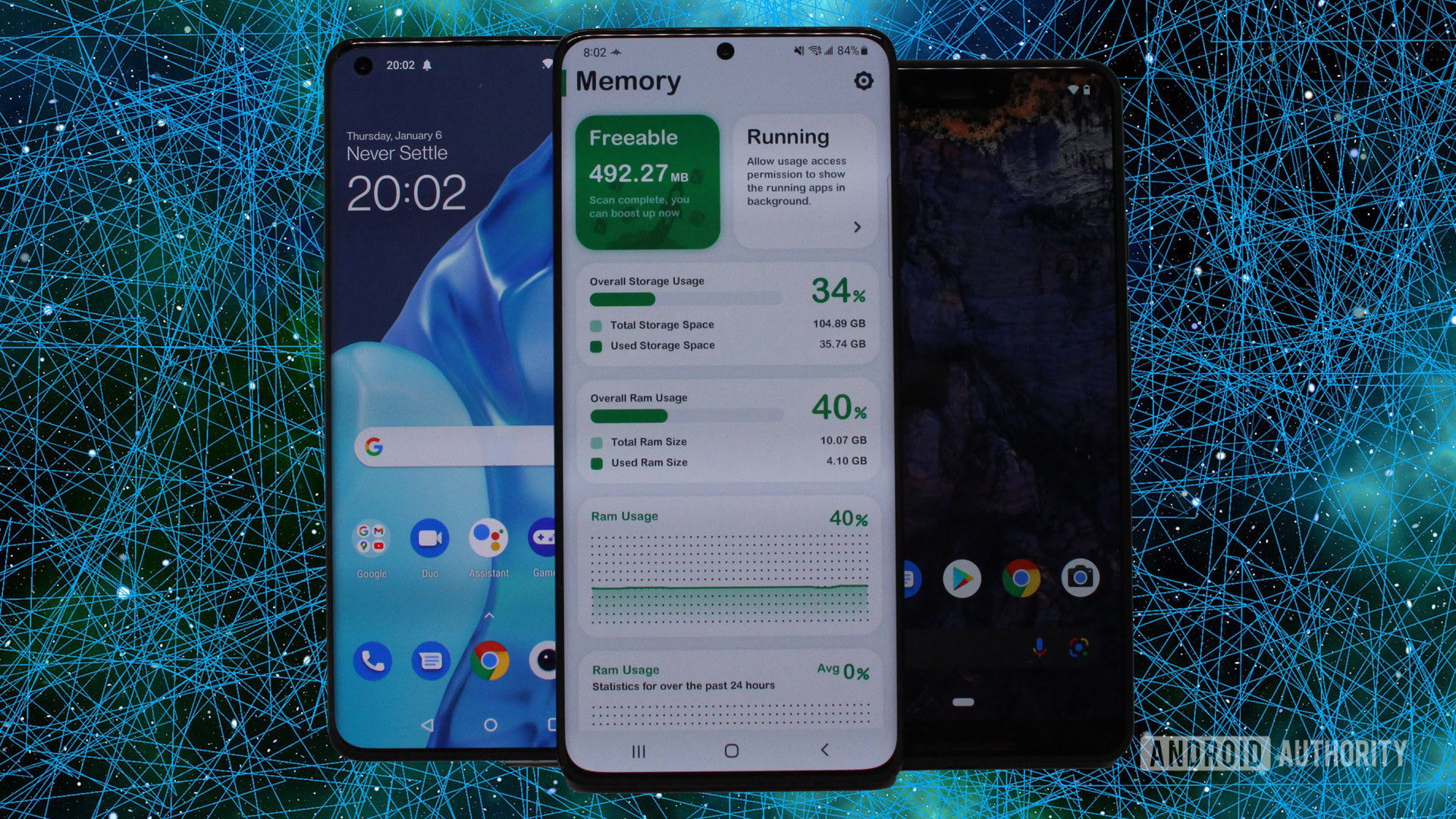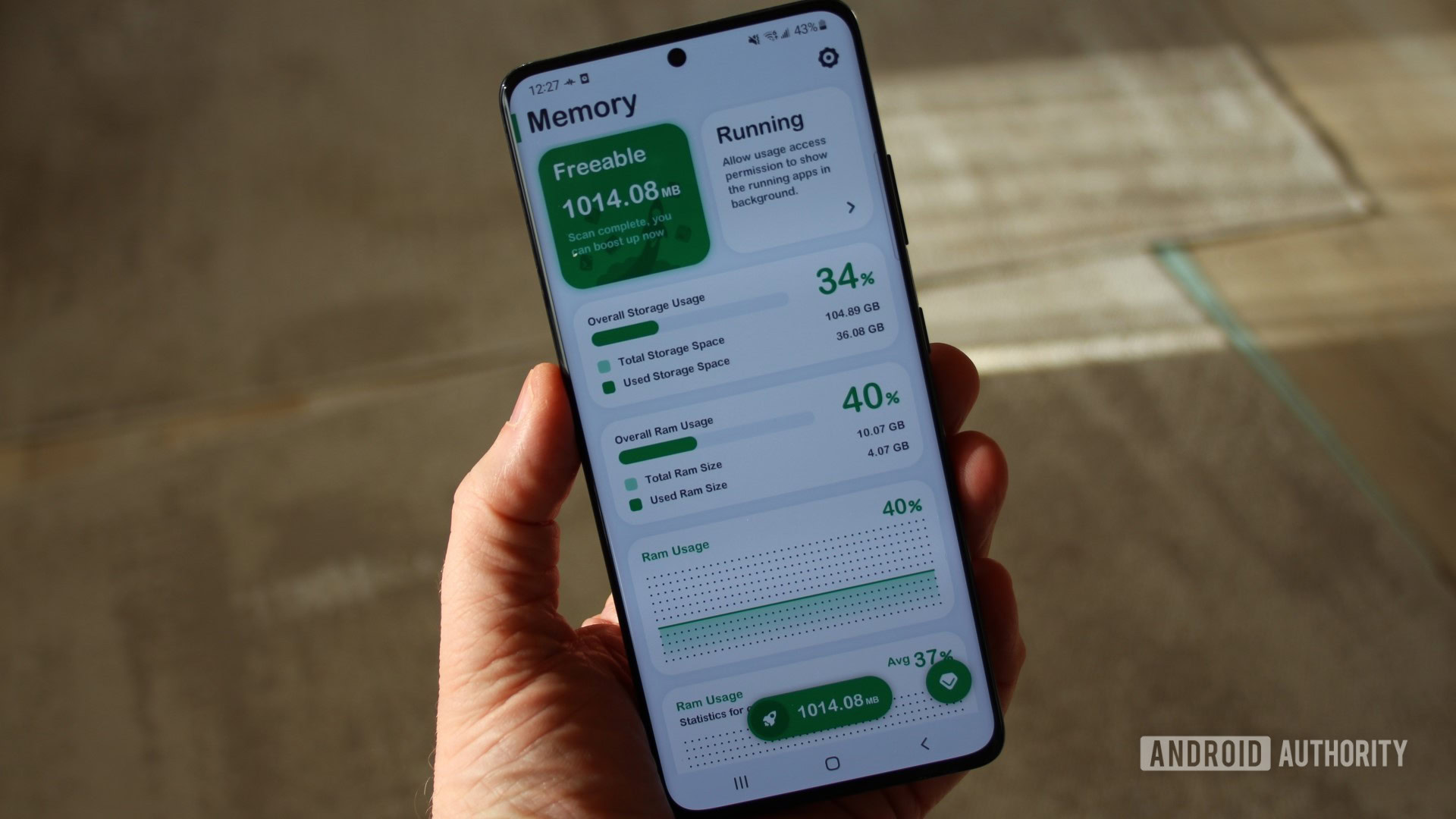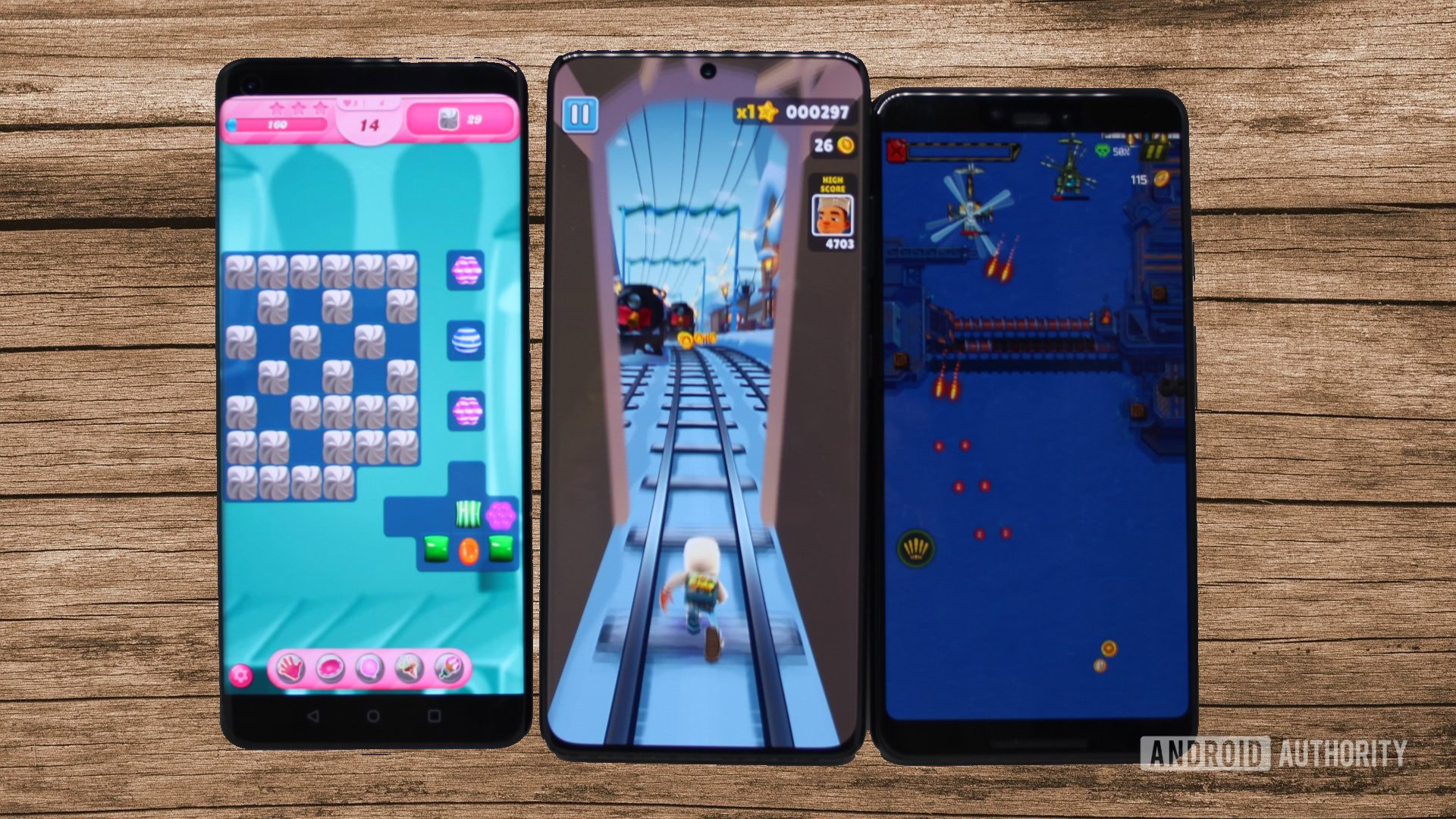Affiliate links on Android Authority may earn us a commission. Learn more.
How much RAM does your Android phone really need in 2024?

The most popular phones feature a wide gamut of RAM sizes. At one end you have some of the best Android phones with as much as 12GB, 16GB, and even 24GB of RAM. On the other hand, budget phones have variants with just 4GB of RAM. Meanwhile, the middle ground is packed with lots of devices with 6GB and often 8GB of RAM.
Generally speaking, less expensive phones tend to have smaller amounts of RAM, while premium, high-end flagships offer much more. The question is, how much RAM do you need when buying a new phone? What’s the ideal amount of RAM for an Android phone in 2024? How much do you need to add a little future-proofing? Let’s find out.
[alert]QUICK ANSWER
Based on our testing, we'd recommend 8GB RAM for most Android users. That said, we noticed tangible benefits to having 12GB of memory as well. While Android phones with 4GB of RAM do exist, it's not enough for a smooth multitasking experience so budget shoppers should look for at least 6GB instead.
RAM vs swap space: Android memory management explained

Every computer, including your smartphone, uses Random Access Memory (RAM). Your currently running programs, their data, and the OS are all stored in RAM while the computer is working. Ten or so years ago, Android devices had 512MB or 1GB of memory. However, the average amount of RAM in devices grew quickly. In 2014, many premium devices had 3GB of RAM and 4GB became the de facto standard a couple of years later. 4GB is now considered the bare minimum for a new device.
No matter how much RAM your device has, it’s a finite resource that has to be managed. Whenever you open a new app, it needs to occupy a portion of this memory. Simple apps and games will use a few hundred megabytes, while more sophisticated games might use up to a gigabyte of RAM. The most demanding games can use up to 1.5GB of RAM.
With 4GB of RAM, there’s just enough room for several medium games or apps, along with the OS, to reside happily together. However, at some point, there will be no more free RAM.
No matter how much RAM your device has, it's a finite resource that can run out. This is where swap space comes in.
To handle this eventuality, modern computers use a technique known as swapping. The oldest and least used pages of memory are written out to the swap storage, and the memory they occupied in RAM becomes free. If that swapped-out memory is needed later, the saved memory pages are read back from storage and copied back into RAM (swapped-in). This greatly increases the amount of available memory to store apps and data but the trade-off is that it’s much slower compared to RAM.
Desktops, laptops, and servers use external storage (hard drives, flash storage) as swap space. Android uses a slightly different technique. Instead of writing out the pages to storage, Android compresses the data and writes it back into RAM. This is known as zRAM, following the Unix/Linux tradition of using “z” to denote compression. If we assume a 50% compression ratio, 128KB of RAM can reduce to 64KB, freeing up 64KB. The Linux kernel that underpins Android sees zRAM exactly as it would see traditional swap space. The compressed memory isn’t directly readable, so if it is needed it must be uncompressed and copied back, just like traditional swapping-in.
However, swap space (especially zRAM) is also a limited resource. If Android runs out of swap space then it needs to become more aggressive and start culling apps already in memory. That means an app you wanted to return to may be forced to close, as Android must make room for the new app you want to start.
If Android runs out of swap space then it needs to get more aggressive and start culling apps already in memory.
What all this means is that the more RAM you have, the more apps you can keep in memory simultaneously without Android killing off older apps. Less RAM means that Android needs to remove apps from memory more frequently. With that in mind, what is the optimum amount of RAM?
Testing to find the ideal amount of RAM

To determine the optimum amount of RAM, I tested three phones: the Samsung Galaxy S21 Ultra with 12GB of RAM, the OnePlus 9 Pro with 8GB of RAM, and the Pixel 3XL with 4GB of RAM. The Samsung and Google devices ran Android 12, while the OnePlus ran Android 11. On each phone, I noted the amount of free RAM and the amount of swap space used. I then launched a game, noted the amount of RAM the game used, and then looked at the changes to the free RAM and the swap space. I repeated these steps until Android was forced to kill off an app already in memory.
It’s worth noting that the tested devices have since been replaced by their 2024 counterparts. But whether you’re using a Galaxy S24 or Pixel 8, the fundamentals of RAM management remain applicable to all Android smartphones
Here is a list of the games I used, along with the average amount of RAM they occupy:
- Subway Surfers — 750MB
- 1945 Airforce — 850MB
- Candy Crush — 350MB
- Brawl Stars — 500MB
- Minecraft — 800MB
- Asphalt 9 — 800MB
- Shadowgun Legends — 900MB
- Elder Scrolls Blades — 950MB
- Genshin Impact — 1.4GB
- Chrome — 2.2GB
Some Android phones allow you to check the RAM available under the About Phone section in Settings. However, you can also check the Developer options > Memory section.
Galaxy S21 Ultra and Pixel 3XL tests
These two devices sit at the extremes of the spectrum. The Galaxy S21 Ultra has 12GB of RAM, whereas the Pixel 3XL has just 4GB. Below is a graph depicting how the devices fared in my test. Along the bottom is the list of games in the order that I launched them. The blue line shows how much free RAM is available and the green line shows how much swap space is used.
As you can see, the S21 Ultra offers an almost textbook example of memory management. As the amount of free RAM decreases, the amount of swap space used increases. With 12GB of RAM, the S21 Ultra was able to hold all of the games in memory, starting with Subway Surfers, then 1945 Air Force, right on through Minecraft, Elder Scrolls Blades, and finally Genshin Impact. Not a single app was killed off.
To push the S21 Ultra to the brink, I started up the Chrome web browser. With 12 open tabs, Chrome had used up 2.2GB of memory, and Android was finally forced to kill Minecraft. Quite impressive. A deeper analysis of what happened can be found in the video.
The 12GB Galaxy S21 Ultra provides textbook memory management and can hold loads of active apps at once.
Things were quite different on the Pixel 3 XL. It was able to hold three games in RAM simultaneously: Subway Surfers, 1945 Airforce, and Candy Crush. When I launched Brawl Stars, Subway Surfers was killed off and removed from memory. As we expected, this smaller amount of RAM means swap space is required with far fewer apps, and only a handful can be held in memory at once.
OnePlus 9 Pro test
The OnePlus 9 Pro used for testing has 8GB of RAM and includes the company’s RAMBoost feature found in many of its devices. RAMBoost tries to make memory management smarter. It analyzes your usage and tries to keep apps you use frequently in memory and kill off the apps that you don’t use often. It will even try to preload certain apps if it determines that you will use them soon. To properly test the OnePlus 9 Pro, I tested it with RAMBoost on and RAMBoost off.
The first thing to note about the test with RAMBoost on is the spike in free RAM when Candy Crush is launched. This occurred because Subway Surfers was killed off, even though there was still plenty of free RAM and swap space available. I restarted Subway Surfers and continued. Brawl Stars started without issue, as did Minecraft. When Asphalt 9 was launched, Android killed off Candy Crush and 1945 Air Force.
The OnePlus 9 Pro is quite aggressive in its memory management, terminating apps while there are still free resources.
With RAMBoost switched off, Android behaves differently. I was able to start all the apps, from Subway Surfers to Minecraft, without anything being killed off along the way. However, when I launched Asphalt 9, the phone killed Subway Surfers.
What is odd about both tests run on the OnePlus 9 Pro is that apps are killed off when there are still free resources. The OnePlus 9 Pro has 4GB of swap space available but only around 1GB is used when apps start being removed. It seems that the OnePlus 9 Pro is quite aggressive in its memory management, especially compared to the other phones I tested.
How much RAM does an Android phone need?

Clearly, 4GB isn’t really enough for an average amount of multitasking. Only the most recent three or four games will remain in memory. Productivity apps tend to be smaller than games, so you should be able to run five or six smaller apps together before some of them reload when you switch back to them. 6GB of RAM will help to alleviate this issue.
12GB on the Galaxy S21 Ultra is very robust and well-managed. At least 15 games, including some rather demanding ones, can remain simultaneously in RAM, including a few browser tabs. I doubt that any average user would have a reason to complain about this level of multitasking capability.
8GB to 12GB RAM is ideal, while 16GB seems to be nothing more than just bragging rights.
While the OnePlus 9 Pro is aggressive in its RAM management, long-term use of RAMBoost should help Android make better use of its 8GB. But I assume that 8GB on other devices will offer a better multitasking experience than on the OnePlus.
It’s also worth noting that on-device AI models are influencing the amount of RAM you might need. Some on-device models are able to run from storage, but some models might need to sit in RAM to improve performance, taking up a big chunk of memory. A Google engineer specifically pointed to the model that powers Smart Reply functionality as an example of a model that needs to reside in RAM on the Pixel 8 Pro. So we’re expecting more phones with 12GB or more RAM in the future.
Based on the results, our recommendation is to aim for a minimum of 6GB of RAM when buying a budget smartphone. For upper-mid-range or high-end devices, 8GB will provide a good multitasking experience plus some future-proofing. What became clear in our testing and in 2024, though, is that 12GB of RAM is clearly useful and should provide a great overall experience for power users and for on-device AI features. It must be said that 16GB RAM seems to be nothing more than just bragging rights for most users, although we expect AI and foldable phones to benefit from this.
FAQs
Yes, 8GB of RAM is enough for most smartphone use cases. That said, power users could benefit from a bump up to 12GB RAM.
Most modern Android phones in the mid-range and flagship price tier include at least 8GB of RAM. We’d recommend no lesser than 6GB for a smooth multi-tasking experience.
No, for intermediate-to-heavy use, we’d recommend at least 6GB of RAM on an Android device. However, for simple calling and texting, you may be fine with just 4GB.
If you’re trying to free up RAM on an Android phone, you can only improve the situation a bit by uninstalling or killing background apps. RAM is a hardware component, although some brands have tried to repurpose storage as RAM.